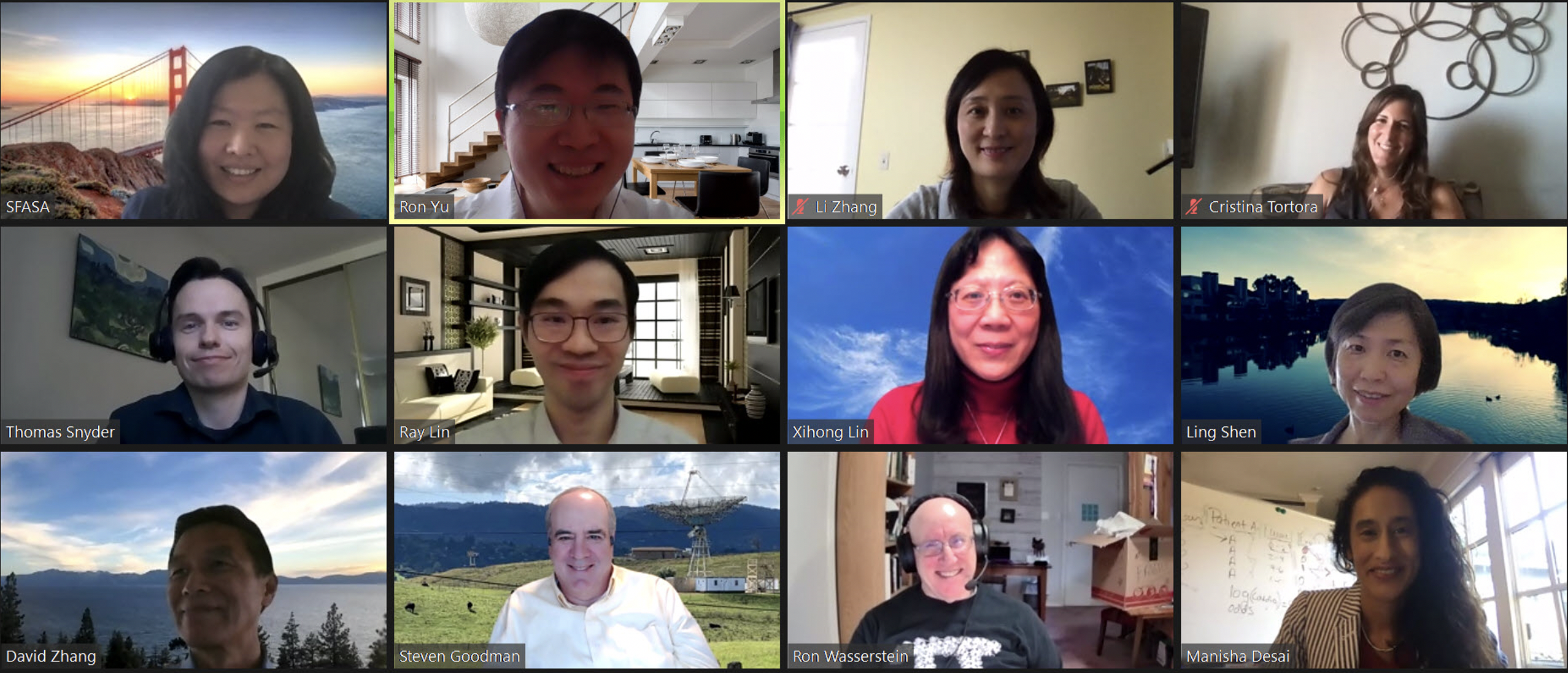SFASA Celebrates Holiday Season with Positive Outlook
Ling Shen, Ron Yu, and Jing Huang
The year 2020 was dominated by an extraordinary effort to combat a deadly virus and survive a lockdown lifestyle. Biotech giants raced to develop COVID-19 diagnostic tests and treatments. Scientists used statistical methodologies to analyze the emerging data and understand COVID-19 transmission and incidence, which drove government policies.
The San Francisco Bay Area Chapter (SFASA) hosted a three-hour virtual celebration December 4, 2020: A Positive Outlook During the COVID Era: How Statistics Could Contribute to a Better 2021. More than 70 SFASA members attended.
Opening Remarks
Tao He, SFASA president, welcomed all attendees and highlighted the chapter’s activities and achievements in 2020.
On behalf of the ASA, Executive Director Ron Wasserstein acknowledged SFASA won the most generous chapter award during ASA Giving Day 2020. He then summarized a few ASA initiatives during the pandemic. To begin with, the ASA Board of Directors formed a COVID-19 task force to respond to emerging issues. They sent letters to government officials and issued public statements about new US Department of Health and Human Services (HHS) guidance for hospital reporting and the role of data experts within the government during public health emergencies. In addition, the ASA created online communities and organized town halls and lectures to improve the quality of statistics education at all levels.
Keynote Presentations
Two invited keynote speakers shared their impactful COVID-19 projects to exemplify the role of statistics and data science in supporting evidence-based strategies to address the pandemic.
Xihong Lin, professor of biostatistics and statistics at Harvard University, and her colleagues were among the first to publish important findings using the Wuhan COVID-19 data. She presented results from her JAMA and Nature publications on COVID-19 transmission, health outcome, and intervention using the Wuhan data. First, she showed that COVID-19 has two features: high transmissibility and high convertness. Before any intervention, the basic Rt value (effective reproductive numbers) was as high as 3.54 in Wuhan before the city lockdown on January 23, 2020. Approximately 87% of cases were unascertained, many of which were likely to be asymptomatic or mildly symptomatic. Using the Wuhan data and the spring data in the US, Lin and her collaborators identified important risk factors and symptoms for COVID-19 infections, including older age, people of color, health care workers, loss of smell and taste, and being exposed in households and communities.
Next, Lin emphasized the importance of multi-pronged public health interventions to combat the pandemic. Data in many countries indicated social distancing alone can reduce Rt to linger around 1. But to bend the curve by further reducing Rt, additional control measures are needed, including mask wearing, widespread testing, contact tracing, supported isolation and quarantine, and vaccination. After enforcing social distancing, universal screening, centralized isolation, and quarantine in Wuhan, Rt was reduced to 0.27 by March 8 and there were zero confirmed cases on March 18. The city was reopened on April 8.
Lin’s group also developed a useful visualization tool, Rt Map, that can be used for visualizing real-time country-level, US state-level, and county-level Rt values to monitor the spread of the virus at different resolutions.
Finally, Lin urged the audience to remain vigilant by keeping the control measures and cautioned of resurgence if preventive measures are lifted immaturely.
Manisha Desai, professor of medicine and biomedical data science at Stanford University, took part in four critical COVID-19 initiatives. First, she served as co-PI to evaluate the impact of a cheap saliva-based self-administered test kit (SnapDx). In the absence of vaccines, a simple home-based test kit is important in managing pandemics, provided the test is feasible with favorable sensitivity and specificity.
Next, to support Bay Area public health departments and guide policies, Desai and University of California, San Francisco (UCSF) co-lead Adam Olshen led their team to develop predictive models to project near-term hospital capacity. Using a parametric bootstrap approach, they simulated the distribution for the worst day of COVID-19 to estimate the probability of being in a safe or more cautionary zone.
In another UCSF/Stanford collaboration, Desai worked with Bay Area counties to estimate the prevalence and incidence of COVID-19 in the Bay Area. To accurately reflect the Bay Area, a stratified random sampling scheme was developed based on two strata—county and risk level—to mitigate the selection bias, where risk is estimated using machine learning approaches. It has been important to work with community-based organizations to engage potential participants and mitigate nonresponse bias once the sample has been selected.
Last, Desai and her colleagues at Stanford University’s School of Medicine launched the COVID-19 Outpatient Pragmatic Platform Study (COPPS). Under COPPS, treatment arms can be added or dropped throughout the study period, allowing viral or clinical endpoints (as defined in the sub-protocol) to be adaptive, flexible, and effective at evaluating multiple potentially efficacious agents in the shared control group. COPPS can accelerate clinical development for COVID-19 treatment without sacrificing scientific rigor of the study.
Panel Discussion
Five panelists provided advice and commentary in response to COVID-19. They offered their perspectives on the pandemic and how scientists could help. In addition, several panelists gave tips and shared personal stories to help the audience cope with this unprecedented situation.
Moderators:
Cristina Tortora, San Jose State University
Ling Shen, Vir Biotechnologies
Panelists:
Manisha Desai, Stanford University
Steven Goodman, Stanford University
Xihong Lin, Harvard University
Thomas Snyder, Adaptive Biotechnologies
David Zhang, MyoKardia
Closing Remarks
Ron Yu, SFASA past president, concluded the event by thanking all the speakers, panelists, event organizers, and participants and wishing everyone a happy holiday season.


















